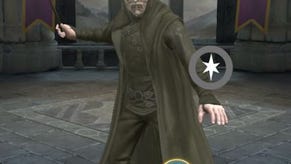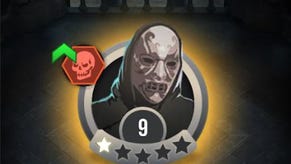Harry Potter: Wizards Unite is a lot more than a Pokemon Go clone - hands on impressions
Niantic and Pokemon are a match made in heaven. Using augmented reality and geo-data to populate our mundane world with fantastical, collectable creatures fulfilled the childhood fantasies of many a grown-up ‘90s kid, while managing to win over their parents, grandparents, and children as well.
It makes sense then to try and make lightning strike twice with an equally - if not even more voraciously - beloved franchise: the wizarding world of Harry Potter.
A collaborative effort between Niantic, Warner Bros. Games San Francisco, and WB’s new Harry Potter publishing label, Portkey Games, Harry Potter: Wizards Unite shares a lot of DNA with Pokemon Go, from the encounter design to the global-scale geo-data underpinning the whole game. But although the central conceit doesn’t line up quite as perfectly as with Pokemon, it’s obvious that a lot of effort has gone into smoothing this disconnect with new features, fresh ideas, and a lot of nerdiness.
A Wizarding World
When you first load up Harry Potter: Wizards Unite, the familiar map interface looks very, very similar to Niantic's previous games, Ingress and Pokemon Go, just wallpapered in Harry Potter’s characteristic faux-British style. Smoke rises from stovepipe chimneys on spired rooftops, while owls and interdepartmental memos flit across the skyline ferrying messages.
The cadence of how you interact with your surroundings is quite different though, with all of your actions tying more closely into the progression of a central story and your character’s abilities as a Witch or Wizard.
Set in modern wizarding times, “The Calamity” has torn pieces of magic from their rightful time and space and scattered them across the Muggle world, threatening to break the International Statute of Wizarding Secrecy and expose magic to the normies. The player’s task is to join up with the Statue of Secrecy Task Force and return these “Foundables” to where they belong.
Foundables are the main encounters in Harry Potter: Wizards Unite, and take a variety of different forms. You might have to help the kindly half-giant Hagrid out of Aragog’s web, zap some magical creature, or cast a Patronus charm to stop Harry getting his face munched off by a Dementor.
Each encounter appears as a glyph on the map that you tap on to enter an Augmented Reality scene - again a lot like like Pokemon Go - where you tap, drag and swipe on your screen to complete the mission. There are plenty of different gestures that you need to trace for different types of encounter, and a lot of them feel distinct from the others. For instance, the battle encounters with dark wizards and magical beasts like werewolves can be genuinely tough, which makes them quite engrossing.
Every encounter has a Threat Level or difficulty rating based on how likely it is to expose the magical world to Muggles, with more dangerous foes taking more effort to defeat, but yielding more rewards.
Completing encounters goes towards marking that object in your Registry, which is split into the following ten categories:
- Care for Magical Creatures
- The Dark Arts
- Hogwarts School
- Legends of Hogwarts
- The Ministry of Magic
- Magizoology
- Magical Games and Sports
- Mysterious Artefacts
- Wonders of the Wizarding World
- Oddities
The Registry works a bit like a sticker album, and you have to complete each encounter around ten times to stick it in for good. Each category has around 15 stickers to collect, which gives a good indication of how much there’ll be to hunt down at launch.
Inns & Greenhouses
Replacing Pokestops on the game map are Inns and Greenhouses, which give you items when you visit them and recharge after a certain amount of time.
Greenhouses specialise in rare potion ingredients, which you can combine with more common ones you find littered around the world in the Potions Lab to create battle items that heal your character or increase your power in fights.
Inns on the other hand, specialise in food which refills the Spell Meter that drains during encounters.
This is probably the most worrying thing that I’ve seen in the game so far. Anyone that played Harry Potter Hogwarts Mystery will remember how oppressive the energy meter in that game was in its effort to aggressively funnel you towards paying microtransactions to progress.
Representatives from WB Games assured me that there would be “no bottlenecks”, but if that’s the case then you have to question the inclusion of an energy meter at all. There are various other currencies throughout the game, too - gold galleons are needed to finish potions, for example. We were told that microtransactions would be available at launch to increase the “efficiency” of gameplay, but not exactly how this would be balanced.
Choose your magical profession
Another of the currencies are scrolls of arcane knowledge, which are linked to an all-new RPG-style character progression system where you pick a class, called a profession, from a list of three.
You can either be an offense-focused Auror, a tanky Magizoologist, or a balanced Professor.
Each class has its own skill tree of abilities you can unlock, but you’re not tied into just one for your whole time with the game. You can freely switch between each job, but they level up independently, so you can’t transfer your progress as an Auror to a new role as a Professor, for instance.
This adds a welcome layer of strategy and complexity to the formula, as well as giving players something to work towards alongside the collect-a-thon.
You professional abilities are then put to use in Wizards Unite’s equivalent of Pokemon Go’s Raids: Wizard Challenge Strongholds.
Teams of up to five players take on increasingly difficult floors of combat encounters in search of rare foundables, and some of the best XP and currency rewards which go to making your character more powerful.
Advanced Augmented Reality
With Wizards Unite, a lot of effort has gone into advancing how you interact with the Augmented Reality components of the game as well.
During encounters with some items you can walk around the models and view them in full 3D, for example. But the best new implementation has to be the collectable Portkeys.
They need a lot of room, so maybe don’t place one next to a fast-flowing river, four lane motorway, or ancient Indian burial ground, but throwing down a Portkey lets you walk around a life-size realisation of a famous location like Ollivander's wand shop in full 3D via Augmented Reality.
It might be a bit of a gimmick, and probably not as fun the tenth time as it is the first, but it’s hard not to get lost in the technology, and is almost certainly the closest thing to magic you’ll find down the local park.
Wizards Unite
Despite no direct involvement from J.K. Rowling and the use of sound-a-like talent throughout, Harry Potter: Wizards Unite is a strongly presented game that progresses the Niantic blueprint with a host of new systems.
It’s a very active game, requiring a lot of open space, concentration, enough encounters to spawn, and likely two free hands to play, which could make playing it under time pressure frustrating, whether in crowded urban areas or sparsely populated rural locations.
Then there’s Niantic’s poor launch record to consider, which could lead to some iffy first impressions because of connectivity issues.
But it would be unwise to doubt the popularity of Harry Potter, and there’s so much good in Wizard’s Unite that if they can get the launch right - and the temptation of overbearing in-app purchases can be resisted - there might just be magic in the air.
Harry Potter: Wizards Unite is due to launch in 2019.












